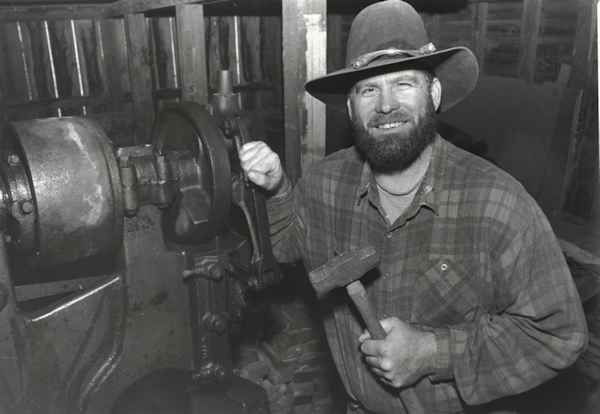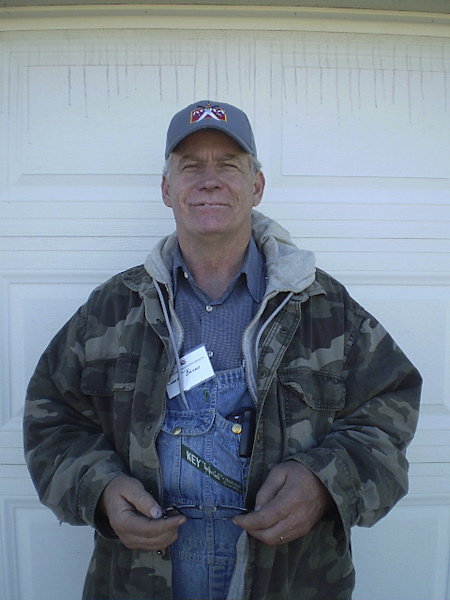I just got a call from Jim Bevan's son. Jim passed away this afternoon. Many of you know Jim from the Heartland Symposium. Jim owned the #25 Little Giant trip-hammer that we used at the symposium.
I'll post more information when I have it.
Sad news indeed. He'll be missed.
Gary
This is indeed very sad news. I remember Jim Bevan from all of his work at our Heartland Hammer-Ins every year in Topeka, Kansas. Jim was always working and helping out at the event and always had a huge smile.
Jim will be missed and our thoughts and prayers to his family and many friends at this time.
Dan Cassidy
Journeyman Smith
Send an email to Dan

Truly sad news. Jim was always fun to be around and willing to help out in any way at the Heartland Hammer In. My condolences go out to his family and many friends. Too many good ones going away this year. I will ring the anvil for him.
Brion
Brion Tomberlin
Anvil Top Custom Knives
ABS Mastersmith
I never met the gentleman, but offer my prayers and best wishes for his family.
Dale
Dale Huckabee
Journeyman Smith
dalehuckabeeknives.weebly.com
I'm aware that many of you did not know Jim Bevan well, other than to have met him at the Heartland Bladesmithing Symposium. Jim was my best friend. He possessed a wealth of information on all forms of metalworking, as well as a tremendous amount of historical knowledge. Jim was always willing to teach and share the things that he knew. He was also fascinated with sprint car racing. He built, owned and drove sprint cars for much of his life. Jim spent the last years of his life working for Rod End Supply, in Olathe, KS. Rod End Supply is a major supplier of suspension parts for race cars, as well as parts for aerospace and industrial applications. Jim was their machinist, making and modifying these parts for their customers.
Jim was an Apprentice Smith with the ABS. He was the Secretary of and one of the founding members of the Kansas Custom Knifemaker's Association. Jim was instrumental in helping me to coordinate the Heartland Symposium. Without his help, it will be much more work for me to put on this event.
I met Jim in 1986, while he was doing a public blacksmithing demonstration. Shortly after meeting him, I became interested in making forged knives. I contacted Jim and asked him if he would teach me blacksmithing. It happened that the Kansas State Historical Society and the Kansas Arts Commission had just started an apprenticeship grant program, where students could get a grant to take a one year apprenticeship with a skilled artisan in a historic craft. Jim and I applied for and received a grant. Jim went on to teach several other guys blacksmithing, through this apprenticeship program. I spent a year learning forging, wheelwright and farrier work from Jim. He showed me how to light my first forge fire. Obviously, Jim was a major influence on me and my work. He and I had some great times over the years.
Jim and I spent about 10 years doing blacksmithing demonstrations together at historic sites, community events and schools around northeast Kansas and eastern Missouri. Jim had a 462 pound anvil that he took to many of these demonstrations. When we had a good crowd gathered around, Jim would tell the onlookers that for one dollar, he would pick the huge anvil up and hold it off the anvil block for three seconds. There was always plenty of people willing to pay to see him do that. Jim would pick the anvil up, count to three and then gather all the one dollar bills held out to him. The funny part was, these people didn't see the real show. Jim had to get that big anvil to the demonstration site. He would bring the anvil to the event in the back of his truck. When he got there, he would pick up the anvil from the back of the truck and carry it over to where we were to do the demo. At the end of our demonstration, of course Jim would carry the anvil back to the truck. Holding that huge anvil for a count of three, was no effort for Jim.
In 1989, Jim and I were running the blacksmith shop at the McLouth Kansas Threshing Bee. The threshing association had been given a 1,600 pound steam hammer, from the Santa Fe railroad shops in Topeka, KS. Jim and I were asked if we could run the steam hammer for the attendees of the event. The steam hammer had two control levers that one operator used to run the hammer, while another operator held the item to be forged between the hammer dies. Jim practiced with the control levers until he learned how to run the hammer. When it came time to do the demonstration, we heated up a large square bar of steel to forge. Our plan was to forge the bar a little on one side, then roll it 90 degrees to forge it some more and reduce it to a smaller square. When the steel was hot, I shoved the bar between the hammer dies and Jim pulled the control levers to run the hammer. The huge hammer hit the steel bar about three times. I yanked the bar out from between the dies and found it to have just a pancake of sheetmetal on the end of it. So much for reducing the bar to a smaller square. Our steam hammer demonstration lasted about two seconds.
I gave Jim the first knife that I ever made. It was a large ugly bowie knife, having all the flaws evident in the work of a beginning knifemaker. Shortly after I gave the knife to Jim, he and I did a blacksmithing demonstration at a 4th of July event in St. Joseph. MO. Jim had brought the knife with him. There were a bunch of muzzleloader enthusiasts at the event, who had set up a target range. Jim and I took our muzzleloading rifles, so we could shoot with them. The first time that Jim went to the shooting range, he gathered his rifle and shooting supplies, then dropped the bowie down the front of this trouser waistband. The knife was razor sharp and did not have a sheath. I asked Jim if he thought that was a good idea. He just grinned, said he would be careful and walked away. About a half hour later, I saw Jim walking back to where I was. His rifle cradled in his arms, a big grin on his face and the bowie again in his waistband. He was completely oblivious to the fact that the knife had sliced through the front of his pants and the blade was hanging out the front of his trousers. We found a nice lady who was doing a sewing demonstration at the event, to stitch up the front of Jim's pants.
I hope you can forgive me for eulogizing my best friend. I just felt that he deserved to be recognized for his contributions to the knifemaking and blacksmithing crafts. Those of you who briefly meet Jim at the Heartland, did not have the opportunity to learn the depth of the man. He was a giant.
I will miss him.
I just got information about services for Jim.
Services for Jim Bevan will be Monday January 5th, at Countryside Christian Church, 3635 NE Highway K-4, Topeka, KS 66617.
Visitation is from 3pm to 5pm. Memorial services will follow immediately after visitation, at 5pm.
James W. Bevan
(February 26, 1954 - December 30, 2104)
James W. Bevan, 60, of Valley Falls passed away on December 30, 2014. Jim was born February 26, 1954 in Paola the son of William and Arleta Jones Bevan. He was raised in Topeka and attended Highland Park High School. He was a machinist by trade. Jim worked at the Santa Fe Railroad as a machinist for over 25 years before retiring. At the time of Jim’s passing, he worked at Rod End Supply in Olathe. He raced sprint cars as part of the Midwest Outlaws Series all over the Mid-West. Other lifelong interests include; Kansas Custom Knife Makers where he was the secretary of the KCKA; American Bladesmith Society; Avid Chiefs Fan and long-time season ticket holder; and blacksmith for over 30 years. He was a blacksmith at the Kansas State Historical Society and many other area historical festivals including, the Meriden Antique Engine and Thrashers Association, Heart of America Antique Steam Engine and Model Appreciation at McLouth; Grasshopper Days in Valley Falls and at events at the Kansas National Guard Museum at Forbes Field in Topeka, Ft. Riley and Ft. Leavenworth. He was married to Judy Shaffer on September 9, 1997 in Ottawa. Those surviving him are his wife Judy of Valley Falls; dad, William Bevan of Topeka; mother, Arleta and husband, Howard Masterson of Melvern; daughter, Courtney Bevan of Chapman; son, Will Bevan and wife Becky of Topeka; step-daughter, Tammy Johns and Mike of Williamsburg; step-son, Michael Farris of Osage City; grandchildren, Caden and McKenna Amack, Jacob Petersen, Megan Petersen, Gabe Petersen, Hayley Johns and Jackson Bevan; siblings, Rosemary Artzer and Tom, Dale Masterson, Richard Masterson, Deb Masterson, Brenda Masterson, Anita Johnston and Keith, Traci Cole, Toni Ramirez and Mark, Kim Harris and Andy, Brad Johnson and Vicki Ellsworth; and numerous nieces and nephews of various generations. Funeral services will be held at 5:00 pm on Monday, January 5, 2015 at Countryside Christian Church, 3635 NW K 4 Highway in Topeka. The family will receive friends from 3-5 pm on Monday at the church prior to the service. Memorial contributions may be made to COF and sent in care of Davidson Funeral Home in Topeka.
I got to know Jim over the last few years and he always amazed me with his knowledge & experiences with both blacksmithing and machinery as well as his willingness to share. He has told me for years that he planned on visiting me in Branson and I regret that it won't happen now. His cheerful demeanor and expertise will be missed.
This has been a sad year in the bladesmithing world. We've lost some valuable assets. Let's hope that the new year is a better one.
Gary
Steve, I really feel for you my friend. Losing a dear friend leaves a hole in your life. My condolences to you and Jim's family.



